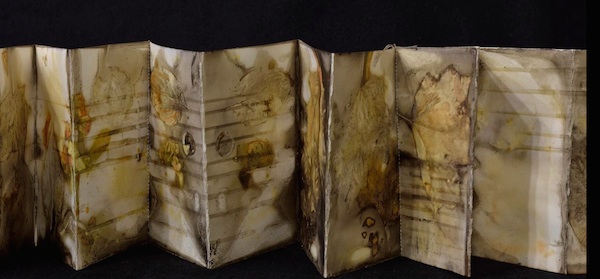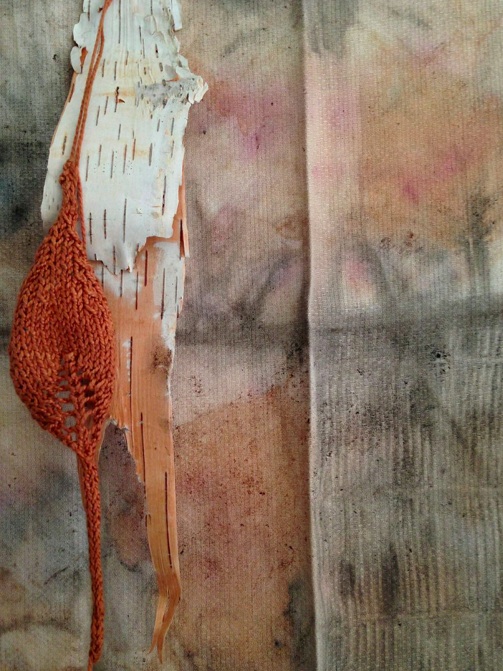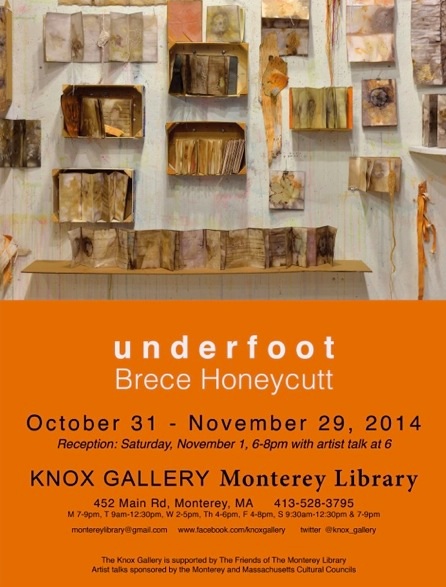Natural dye and textile artist Brece Honeycutt says that over the past few months, her studio wall has been transformed into an installation of handmade sculptural books, “some stacked on shelves or wedged into small crates, and others hung directly onto the wall so that the pages cascade down,” giving the viewer, another way of seeing nature.
This weekend, Honeycutt’s installation, a deliciously earthly narrative will feature works on paper and cast-off textiles at the Knox Gallery in Monterey Massachusetts, for a solo exhibition called Underfoot. The exhibition will showcase interpretations of old books happened upon in archives, showing their wear and tear; reading lists written on sheets of paper and stained with use as well as ‘books’ printed and sewn by hand with materials from the land.
In addition to being a an avid explorer of textiles and natural dyes, Honeycutt also spent time as a cataloger and worked the circulation desk at her local library where she got to have a continual love affair with books both old and new. Outside the doors of the library and all around her 1753 center chimney colonial house, she has become more and more curious about the landscape on the other side of her studio door. While plants like dandelions, plantain, mugwort, ragweed, barberry and others become both images and materials in her art, in the form of dyes and print matter, these same plants are providing the artist another avenue of research for her work and “drawn her further into etymology, appellations and vernacular.”
Underfoot can be viewed at the Knox Gallery, Monterey Library, 452 Main Road Monterey, MA, on November 1st with an artist’s talk at 6 pm that evening and a reception immediately following.
For more information call 413-528-3795.
We caught up with Honeycutt to see if she could dive a little deeper for us into her creative process:
Underfoot seems to connect nature to our everydayness pulling in books and stitching… What is the overall feeling you want a viewer to walk away from after they’ve seen your show?
Before one deems something useless, outdated, or outmoded, please reconsider. For example, look down when you walk and when you see plantain growing, now realize that it can be used to stop an insect bite from itching. Before throwing out a perfectly good t-shirt, only to purchase a new one, re-dye it, use for a rag, or make a necklace (Alabama Chanin), but know that each item has both ecological and human costs and it still has value.
You reference “nature’s abundance,” and have scrap textiles in your exhibit. Do you feel as a society we are overlooking how much we do actually have “underfoot” and don’t realize it?
When I work, I very much like to use remnants, rags, cast-offs, weeds–the useless turned into something valued. The summer affords many materials for gathering, both off the land and at ‘tag’ sales. Stacked on tables and stashed in trunks, aged, stained, ironed linens are shamelessly cheap finds. Daily the garden yields plants that provide dyes–spent morning glory flowers, coreopsis, marigold and zinnia flowers, golden rod, mint and Jerusalem Artichoke flowers and leaves. As the nights become cooler, the black walnut tree drops its treasure–nut hulls. Leaves fall and must be gathered. The mighty ever-present, omnipresent invasive–barberry–provides a lovely yellow green dye.
Talk about the influence of your grandmother in terms of how she has played a hand in your show.
Josie Dean Kenworthy Honeycutt. I spent every summer with my grandmother until the teenager ‘summer’ job took precedence. She had a garden and canned; she had a sewing machine and made clothes; and her attic was filled to the brim with older, discarded objects (adding machines with crank handles, for example). In retrospect, I realize that she was in her twenties during the Depression and it became her habit to save and reuse. In my bedroom, the dresser drawers were filled with rolled up cloth remnants, tied in neat bundles, waiting to be used. Sometimes these remnants were pieced into quilts, and if there was enough, a new summer dress made.
In the evenings, I would secretly open the drawers, pull out the bundles and admire the patterns and textures. Watching my grandmother use the ‘old’ coupled with the new is something I think about, and employ, regularly.
Life on a farm or life in the city-which inspires you more to create?
We moved from Washington, DC to Sheffield, Massachusetts seven years ago. Whilst in DC, on my morning walks, I combed the alleys for cast-off items to literally cast in paper or to draw. My scavenger nature did not leave me when we moved to this old farm, but my gathering grounds are quite different. While we originally anticipated “reclaiming” the land, in fact we have worked more closely with nature, allowing it to teach us and guide us. Literally, the land is giving me materials. Are ‘weeds’ really worthless? Absolutely not; these wayside plants are useful for dyes, home remedies, food, and often the plant needed by the foraging honeybee.
What are some of the dyes you are using and can you just very briefly tell me your dyeing process?
Dyes are made from gathered natural materials around my studio and on our land: barberry, golden rod, black walnut, mugwort, rhododendron leaves, birch bark and leaves, Jerusalem Artichoke and mint. The castoff linens and sheets of paper are folded and interleaved with flowers, leaves, metal pieces; and then bundled with metal graters, spatulas, pieces of copper or a sushi mat on the exterior and tied up with string.
The bundles are immersed in a dye bath, simmered for 45 minutes, and sit over night. Once pulled from the bath, the ‘printing’ process continues. The longer one can bear to wait, the better the print from the spatula, grater, flowers or old nails. Unbundling is a treat, for one now sees the magic unfurl: traces of leaves, rusty marks from the spatula, black lines of colonial nails from our house, bright blue and purple morning glory dots. The newly dyed pieces are hung on the line to dry in the shade.
Finally, ironing the finished product. The textiles (napkins, table clothes, runners) returned to their ‘proper’ state. The beauty of the well used, loved and worn cloth is now revealed; small holes, mended places, and the many textures of the linen and cotton. The visual impacts from my dyeing provide an important tangibility to these renewed fabrics.





Comments are closed.